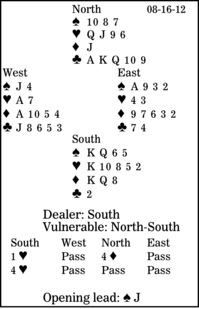Bridge column, August 16: How many cards does he hold?

The grand aim of all bridge players is to find the greatest number of correct bids and plays by logical deduction.
How does East find the right defense in this deal? The contract is four hearts. West leads the spade jack. What should East do? Also, what should North bid when South opens one heart?
North's response depends upon partnership methods. My top choice would be three clubs, a strong jump shift. When North supports hearts on the next round, it shows four-plus hearts, five-plus good clubs and 13 to 16 high-card points. Alternatively, North can show his second-best feature, his diamond singleton, by making a splinter bid of four diamonds. The third sensible choice is two no-trump, the Jacoby Forcing Raise. (I do not like two clubs then heart support, because that would show at most three hearts.)
What is West's lead? Given the 10 in the dummy, it must be a singleton or the higher card from a doubleton. But which?
If it's a singleton, South would have five spades to the king-queen and surely would have opened one spade, not one heart. So East should deduce that West has led from a doubleton and encourage with the nine.
Then, when West gets in with the heart ace, he can lead his second spade and receive his ruff. The diamond ace will be the fourth defensive trick.
Yes, declarer should cash dummy's top clubs to discard spades, but that does not work here.
** ** **
COPYRIGHT: 2012, UNITED FEATURE SYNDICATE
DISTRIBUTED BY UNIVERSAL UCLICK FOR UFS

